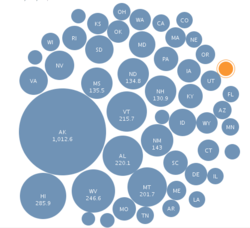Pork Part 2: How Earmarks Shortchange New York
Part one of my earmarks series was a basic introduction to earmarks. In part two of my series on earmarks, I want to show how earmarks shortchange New Yorkers, and how earmarks directed to small, red states come out of our pockets.
Last
year, I wrote a
piece that pointed out the general inequity in redistribution of
tax dollars. In 2004, New York was 43rd in the ranking of states
receiving money back from the federal government. For every dollar of
taxes paid in to the Federal Government, New York got 79 cents back.
My piece also presented a couple of examples of deluxe airports in
North Dakota financed in large part by homeland security money. In
2004, North Dakota received $1.73 for every dollar sent to Washington,
more than twice New York's share.
 The "dollars back" picture is
The "dollars back" picture is
for overall federal funding. The picture for earmarks is even more
grim. The chart at right is from the
Many Eyes project. The size of the dots indicate the per-capita
amount of earmark money received by each state in 2005. The big fat
dot is Alaska, which received a stunning $1,012 per person in
earmarks. North Dakota's no Alaska, but its two senators and one
representative managed to wrangle $135 per person. You might need to
get out a magnifying glass to see New York's paltry $29 per person --
we're the little orange dot at the right.
It's no coincidence
that some of the biggest abuses of both earmarks and grants have come
from the smallest states. The
nowhere" in Alaska is the most popular example. The few million
dollars in earmarks obtained by Randy Kuhl are dwarfed by this $223
million bridge. It's also no coincidence the two most senior members
of the Alaska delegation are under
investigation, and one may
have been recorded accepting bribes..
The immense direct
power of earmarking leads to huge temptation to use that power for
personal gain. Even if there's no corruption involved, the
redistribution of tax dollars favors small, rural states. Because of
earmarks, New Yorkers are paying extra taxes to fund silly stuff like
go-nowhere bridges and palatial, untraveled airports.
Neither
candidate in this race has yet raised the fairness issue, but I think
it's worth a look, especially because it cuts across party lines.
Small-government conservatives should be disturbed by the amount of
federal intrusion required to redistribute our funds to rural states.
Anti-corporatist and pro-grassroots progressives should be bothered by
the degree of corporate control exercised via DC lobbyists.
Even though conservatives and progressives should be united on this
issue, it's a tough sell in the current environment. Local and
state governments have come to rely on a steady stream of grants and
earmarks to finance local projects. Congressmen and Senators have
made their ability to deliver pork a cornerstone of their campaigns
and fundraising efforts. Neither local nor national legislators
want to risk a change in a system that they've spent their careers
learning to manipulate.
Comments
Hi Rottenchester,
Thanks for using the earmarks visualization tool the Sunlight Foundation (my employer) created using Many Eyes. Glad you're finding it useful.
Since you already monitor earmark spending, I thought you might want to check out our new online investigative tool, EarmarkWatch.org . EarmarkWatch.org lets you determine if earmarks address pressing needs, favor political contributors or are simply pure pork.